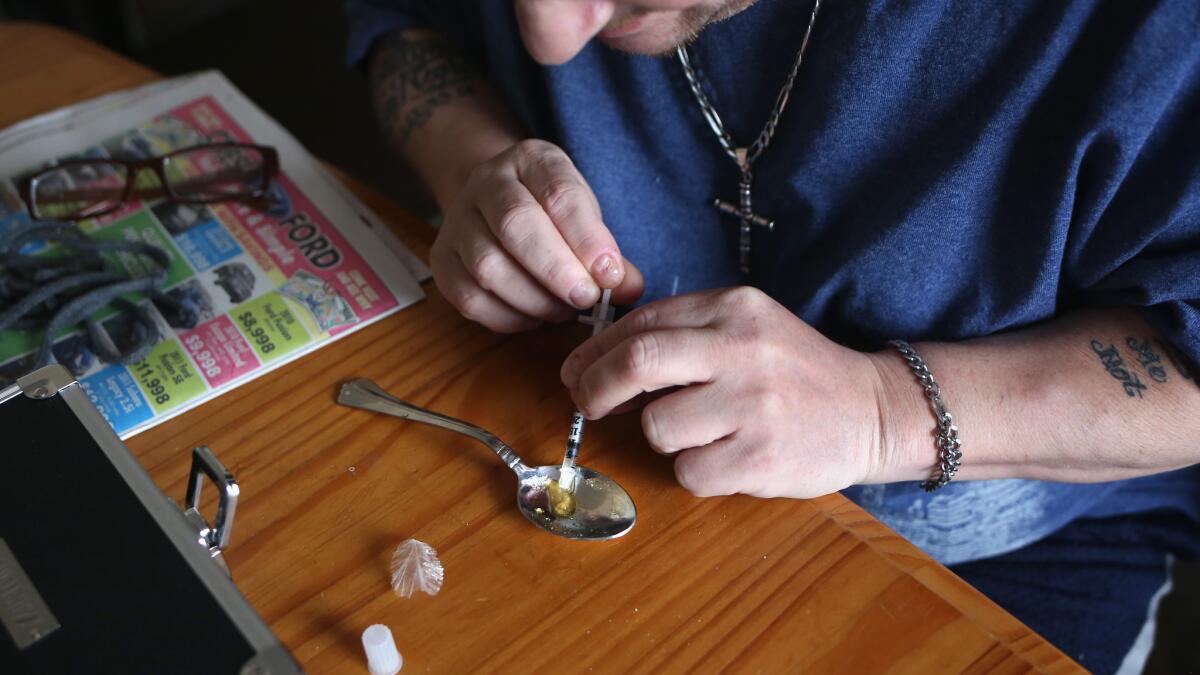Seattle’s new war on drugs: Giving heroin addicts ‘safe sites’ to shoot up

Seattle is moving toward opening government-financed clinics where addicts can legally take narcotics.
- Share via
Reporting from Seattle — Seattle officials are moving forward with a controversial plan for what would be the nation’s first supervised heroin-injection clinics — government-financed shooting galleries that supporters say can save lives but that critics say will only enable drug users.
A new 99-page task force study envisions at least two safe-use facilities — one in Seattle, another in the suburbs — where heroin addicts can legally take narcotics while being monitored by medical personnel who can administer aid or call 911 if needed.
The project is modeled after North America’s first supervised heroin haven, InSite, a government-funded injection facility 140 miles north in Vancouver, B.C., which in 13 years of operation has never had an overdose fatality, officials there say.
See the most-read stories this hour »
That success has inspired other cities — including San Francisco, Los Angeles and Portland — to consider government-approved safe sites for addicts to inject heroin. But Seattle is moving fastest, convinced there is “urgent need for action,” as the new study puts it.
“For me personally, what has worked,” says Seattle social worker Thea Oliphant-Wells, a task force member and recovering heroin addict for 11 years, “was to have harm-reduction folks engaging me long before I was ready to change my drug-abuse behavior. I promise you, when you give people the opportunity to get better, they will.”
Jeff Duchin, head of Seattle-King County Public Health, said the safe sites — officially known as Community Health Engagement Locations — will increase the odds for drug users to return to healthy lives by reducing overdoses, preventing HIV and other infections and cutting down on other drug-related medical problems.
The proposal has the support of King County’s chief executive and the mayor of Seattle, a city once dubbed by Rolling Stone as “Junkie Town.” Heroin use here and across the U.S. dripped, then spiked in the last decade as Americans addicted to pain killers such as OxyContin and Percocet looked to the streets for cheaper alternatives.

A United Nations study released this summer found that use of heroin has soared in the last two decades. U.S. deaths related to the narcotic have increased fivefold since 2000 and the number of U.S. users has tripled to one million in that time.
In King County, with good Samaritan laws that prevent prosecution of anyone who, in good faith, aids an overdose victim, and with wider use of the recovery drug Naloxone by first responders, overdose deaths actually dropped last year — 132, compared with 156 in 2014.
But from 2010 to 2014, the number of users seeking treatment here doubled from 1,439 to 2,886, and the death toll in 2015 was a third higher than two years ago.
With no apparent end to the upward trend, local officials say safe-use sites are a worthy intervention.
“If it’s a strategy that saves lives then regardless of the political discomfort, I think it is something we have to move forward,” said County Executive Dow Constantine, discussing the plan at a news conference last week.
Seattle police have taken a wait-and-see position, but King County Sheriff John Urquhart told the Los Angeles Times earlier this year that he sees the safe-injection plan as workable.
“As long as there was strong, very strong, emphasis on education, services, and recovery, I would say that yes, the benefits outweigh the drawbacks,” he said. “We will never make any headway in the war on drugs until we turn the war into a health issue.”
The injection clinics are among a list of task force recommendations that include expanding education, treatment and needle-exchange programs. No cost estimates have been given, but pilot-project funding is being sought. The clinics, besides providing overdose prevention and treatment, would include provisions for basic medical treatment and social services assistance.
Mayor Ed Murray is cautiously optimistic about the idea, saying clinic locations must not adversely affect neighborhoods. His office is already getting objections from residents who worry their community could come to resemble Vancouver’s Downtown Eastside, Canada’s poorest neighborhood, where the InSite clinic operates.
Safe-consumption sites for the addicted are not new in Seattle. The city has established a successful housing project for alcoholics that allow residents to drink in their rooms. Officials say it saves taxpayers $4 million a year in emergency services and other aid for homeless alcoholics.
Shilo Murphy, director of Seattle’s 25-year-old needle exchange program — the largest in the U.S. — told The Times in June: “We’ve got to try something different.” A task force member, he’s pushing for a novel addition to the proposal — a large van, or mobile shooting gallery, with a medical assistant, traveling to targeted neighborhoods and offering supervised injections.
Doing something different is also the hope of Nancy Backus. That’s because, says the mayor of suburban Auburn, Wash., the situation is different today.
“There isn’t really one face of addiction any longer. We can no longer drive by or walk by any one person and say, ‘Oh, that person is addicted to drugs.’ It’s our sons. It’s our daughters. It’s our mothers and fathers. It’s our friends and loved ones. And we no longer have the luxury of pretending it doesn’t impact each and every one of us.”
Anderson is a special correspondent.
ALSO
FDA asks coders to create an app that matches opioid overdose victims with lifesaving rescue drug
What you need to know about Prop. 61, the spendy prescription drug measure on November’s ballot
The battles began in 1964: Here’s a look at Colombia’s war with the FARC rebels
More to Read
Sign up for Essential California
The most important California stories and recommendations in your inbox every morning.
You may occasionally receive promotional content from the Los Angeles Times.










